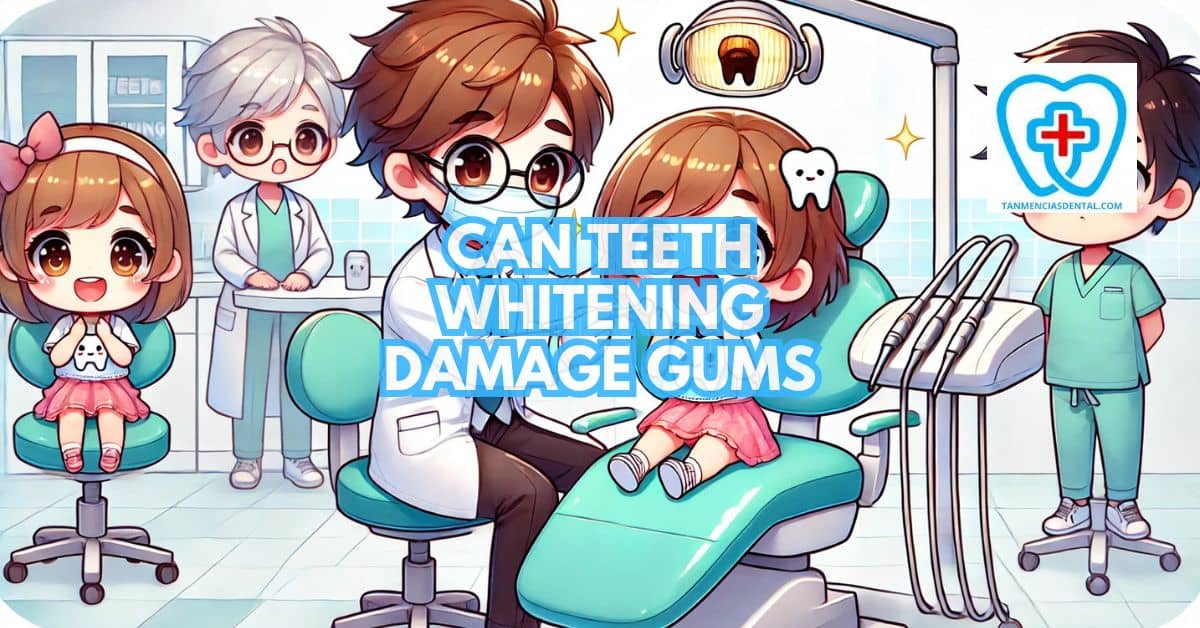Teeth whitening is a common way to enhance a smile, but it can have unintended side effects.
Many wonder, “Can teeth whitening damage gums?”
The answer is yes, especially if products are misused.
Whitening agents contain strong chemicals that can irritate or harm gum tissue.
Understanding how these treatments work and their effects can help you make safer choices.
1. What Is Teeth Whitening and How Does It Work?
Teeth whitening uses bleaching agents to remove stains and discoloration.
These agents, typically hydrogen peroxide or carbamide peroxide, break down stain molecules on the enamel.
The chemicals penetrate the outer layer of the teeth to lift stains, making them appear whiter.
However, when these substances come into contact with the gums, they can cause irritation and discomfort.
Frequent exposure can lead to gum inflammation, increased sensitivity, or even chemical burns.
🦷 Can Retainers Straighten Teeth Without Braces?
2. How Teeth Whitening Products Can Affect Your Gums
Whitening products can irritate if they come into direct contact with the gums.
Many gels, strips, and trays do not stay confined to the teeth, increasing the likelihood of gum exposure.
This can result in mild discomfort, burning sensations, or visible sores on the gum tissue.
Stronger whitening solutions tend to cause more severe irritation.
Using poorly fitted trays or applying too much whitening gel can further increase gum sensitivity.
🦷 Can Quotes About Brushing Your Teeth Actually Make You Look Forward to Brushing?
3. The Role of Chemicals in Whitening Products and Gum Irritation
Whitening products contain strong, active ingredients that break down stains but can also weaken gum tissue.
Hydrogen peroxide and carbamide peroxide act as oxidizing agents that can strip away protective layers.
When these chemicals touch the gums, they may cause redness, inflammation, and soreness.
Prolonged exposure may lead to increased gum sensitivity and a higher risk of damage.
Some whitening solutions also include alcohol or preservatives that contribute to irritation.
🦷 Can You Use Whitening Toothpaste With Braces? What You Need to Know
4. The Risks of Overusing Teeth Whitening Treatments
Using whitening products too frequently can lead to gum inflammation and enamel erosion.
Overuse of these treatments can strip essential minerals from teeth, making them weaker and more sensitive.
Additionally, excessive whitening can cause gums to recede, exposing more of the tooth root.
Uneven whitening and persistent gum soreness are also common side effects.
Those who whiten too often may experience chronic discomfort that requires professional dental care.
🦷 Can Veneers Get Cavities? Here’s What Your Dentist Wants You to Know
5. Understanding Gum Sensitivity and Its Impact on Whitening
People with naturally sensitive gums are more likely to experience pain or irritation during whitening treatments.
Thin gum tissue, receding gums, or pre-existing oral conditions can increase the risk of discomfort.
Whitening products may intensify sensitivity, leading to sharp pain or lingering soreness.
If gums are already inflamed or damaged, whitening agents can make the problem worse.
Individuals with gum sensitivity should opt for milder treatments or seek professional advice before whitening.
🦷 Can You Whiten Bonded Teeth Effectively at Home?
6. Signs That Teeth Whitening Is Damaging Your Gums
Gum damage from whitening can appear as redness, swelling, or tenderness.
Some people may notice white patches or peeling gum tissue, which indicates chemical burns.
Bleeding when brushing or flossing after whitening is another warning sign.
If irritation persists for several days, it could be a sign of more serious damage requiring dental attention.
Severe pain or gum recession could indicate long-term harm that may not be reversible.
🦷 Essential Tips for Maintaining Good Oral Hygiene
7. At-Home vs. Professional Whitening: Which Is Safer for Your Gums?
Professional whitening treatments are generally safer because dentists use protective barriers to shield the gums.
They also create custom-fitted trays to prevent excessive gel from spreading onto gum tissue.
Over-the-counter whitening kits often include ill-fitting trays or strips that increase gum exposure.
As a result, at-home treatments carry a higher risk of gum irritation.
While professional whitening is more expensive, it provides better results with fewer side effects.
🦷 Do Chipped Teeth Heal? Why Professional Treatment Is Often Necessary
8. How to Protect Your Gums While Whitening Your Teeth
Applying a barrier, such as petroleum jelly, along the gum line can help shield gums from whitening agents.
Custom-fitted trays are recommended to keep the gel contained and prevent it from spreading onto soft tissues.
Following product instructions carefully and avoiding overuse can minimize irritation.
Choosing lower-concentration whitening products can also be gentler on sensitive gums.
Taking breaks between treatments allows gums to recover and reduces the likelihood of long-term damage.
🦷 What Happens If You Don’t Brush Your Teeth With Braces?
9. What to Do if Whitening Causes Gum Damage
If gum irritation occurs, stop using the whitening product immediately.
Rinse your mouth with warm salt water to soothe inflammation and promote healing.
Applying an oral gel with aloe vera or another soothing agent can help reduce discomfort.
If pain or irritation persists, consulting a dentist is the best course of action.
Avoid spicy, acidic, or rough foods while your gums heal to prevent further irritation.
🦷 Can Crowns Get Cavities? Understanding the Risks and What You Can Do
10. Safer Alternatives for Whitening Sensitive Gums
People with sensitive gums may benefit from whitening toothpaste, which provides gradual brightening without harsh chemicals.
Natural options, such as baking soda or activated charcoal, can remove stains with less irritation.
Professional treatments like laser whitening offer a safer way to whiten teeth while minimizing gum exposure.
Using whitening strips designed for sensitive teeth can also be a gentler approach.
Drinking water after consuming stain-causing foods can help maintain a whiter smile naturally.
🦷 Tan-Mencias Orthodontics in Marikina
👨⚕️ Conclusion
Teeth whitening can damage gums if not done properly, but taking precautions can reduce the risk.
Professional treatments, protective measures, and careful product use can help keep gums safe.
If irritation occurs, stopping treatment and taking steps to heal the gums is essential.
Those with sensitive gums should consider milder alternatives or seek guidance from a dentist.
By making informed choices, you can achieve a brighter smile without compromising gum health.
😊 Self-Promotion
Looking for a trusted dental clinic in Parang, Marikina City?
Visit Tan-Mencias Dental Clinic for expert care and a friendly atmosphere that will make you feel at ease.
If you have any questions, you can call us at 0917-145-1074, message us on our Facebook page, or reach out through our website’s contact form.
We are always happy to help with your dental needs!
Book your appointment today, and let us keep your smile healthy and bright.

